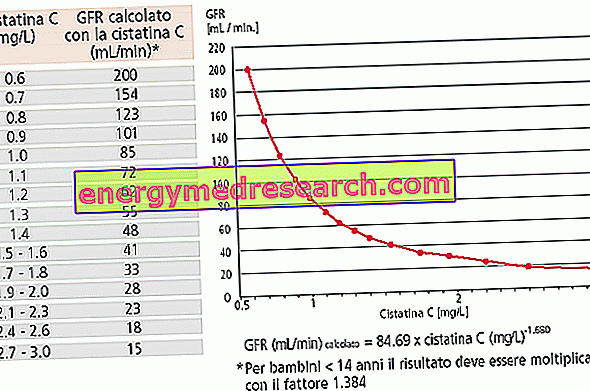Generality
Cystatin C is a measurable blood protein that provides information on the state of renal function .

What's this
Cystatin C is constantly produced from all types of nucleated cells in the body.
Its relatively small molecular mass (120 amino acids) allows:
- Easy filtration by the glomerular membranes of the kidney;
- Rapid reabsorption and metabolization by tubular cells.
The rate at which the liquid - which also contains Cistatin C - is filtered by the kidneys is called glomerular filtration rate (GFR) .
A decrease in renal function leads to a decrease in GFR and an increase in blood levels of cystatin C and waste compounds, such as creatinine (a product of muscle metabolism, measurable in blood and urine).
Unlike creatinine, cystatin C is not significantly affected by muscle mass (sex or age) and diet (especially protein).
Biological role
Cystatin C is a low molecular weight protein that acts as an inhibitor of cysteine proteases; as such, cystatin C is important for stopping the action of these enzymes involved in the destruction of abnormal cells and proteins, which would become dangerous if left free to attack even the body's "healthy" proteins.
Why do you measure
Cystatin C is produced in almost constant quantities by all nucleated cells. It is then found in the plasma and, thanks to its low molecular weight, it is freely filtered by the renal glomeruli, then reabsorbed and catabolized about 99% into the proximal tubule (it is not secreted).
Consequently, in physiological conditions its concentration in the urine is almost zero; the dosage of cystatin C in the plasma represents therefore an excellent endogenous marker of renal function, superior also to the traditional creatininemia and to the formulas based on it.
When is the exam prescribed?
- The dosage of cystatin C in the blood is indicated when the doctor suspects that kidney function is impaired.
- The examination can be prescribed at regular intervals to monitor the dysfunction in patients suffering from kidney disease.
The tests associated with the determination of cystatin C usually include creatininemia (a measure of creatinine), a urea assay and eGFR (usually estimated GFR based on the concentration of creatinine in the blood).
Normal values
Cystatin C is produced in constant quantities by all cells and does not depend significantly on weight and lean mass (except for the most extreme groups of body composition), from age (except for the 1st year of life ), by gender or race.
After the first year of life, the Cistatin C values remain almost constant until the age of 70, when there is a gradual decline of the glomerular filtrate related to aging, therefore a corresponding increase in the levels of cystatin C in the blood. Furthermore, this marker of renal function does not appear to be influenced by various metabolites or medicaments (except glucocorticoids) which distort the analysis of creatininemia (such as bilirubin, ketones, cyclosporine, cephalosporins or aspirin).

Cystatin C High - Causes
When the kidneys function normally, the concentration of cystatin C in the blood is stable, but as kidney function deteriorates, it begins to increase.
A high serum concentration of cystatin C corresponds to a decrease in glomerular filtration rate (GFR) and to renal failure.
Since cystatin C is produced in the body at a constant rate and is metabolised by the kidneys, it should remain at a constant blood concentration if the kidneys function efficiently and GFR is normal.
Low Cystatin C - Causes
Cyclosporine intake may decrease the concentration of cystatin C.
How to measure it
The dosage of cystatin C involves the collection of a blood sample from a vein in the arm.
Preparation
In the 8-12 hours prior to the cystatin C examination, the patient may be required to remain fasting.
Interpretation of Results
Cystatin C and kidney health
Serum cystatin C levels mainly depend on the glomerular filtrate, ie the amount of plasma that the kidneys can filter in one minute; consequently, if the renal activity is compromised by a disease, the plasma levels of cystatin C increase and the glomerular filtration is reduced. Even in diabetic subjects (both type 1 and type 2) cystatin C is considered, in association with microalbuminuria, an early marker of renal damage.
The dosage of cystatin C then finds another important application in all those conditions that can determine a reduction in creatininemia and, consequently, an overestimation of the glomerular filtrate; this is the case, for example, of old age, protein-calorie malnutrition, liver cirrhosis and cachexia (noticeable reduction in muscle mass).
The fact that cystatin C concentrations do not depend significantly on the amount of muscle mass (except in extreme cases) is an important advantage even for those who practice muscle training, such as bodybuilders, who are often alarmed by high creatine levels and azotemia, actually physiological in most cases.
Being a marker of recent clinical use, it is likely that in the next few years there will be a greater diffusion of the cystatin C dosage, a widening of its clinical significance and a better definition of the reference parameters in the various population groups.



